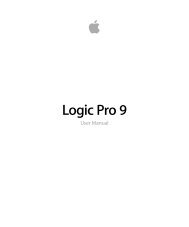Soundtrack Pro 3 Effects Reference (en).pdf - Help Library - Apple
Soundtrack Pro 3 Effects Reference (en).pdf - Help Library - Apple
Soundtrack Pro 3 Effects Reference (en).pdf - Help Library - Apple
You also want an ePaper? Increase the reach of your titles
YUMPU automatically turns print PDFs into web optimized ePapers that Google loves.
• Feedback slider and field: Determines the amount of the effect signal that is routed back<br />
into the input of the effect.<br />
Phaser Sweep Section<br />
• Ceiling and Floor slider and fields: Use the individual slider handles to determine the<br />
frequ<strong>en</strong>cy range affected by the LFO modulations.<br />
• Order slider and field: Allows you to choose betwe<strong>en</strong> differ<strong>en</strong>t phaser algorithms. The<br />
more orders a phaser has, the heavier the effect.<br />
The 4, 6, 8, 10, and 12 settings put five differ<strong>en</strong>t phaser algorithms at your fingertips.<br />
All are modeled on analog circuits, with each designed for a specific application.<br />
You are free to select odd-numbered settings (5, 7, 9, 11), which, strictly speaking, don’t<br />
g<strong>en</strong>erate actual phasing. The more subtle comb filtering effects produced by<br />
odd-numbered settings can, however, come in handy on occasion.<br />
• Env Follow slider and field: Determines the impact of incoming signal levels on the<br />
frequ<strong>en</strong>cy range (as set with the Ceiling and Floor controls).<br />
Phaser LFO Section<br />
• LFO 1 and LFO 2 Rate knobs and fields: Set the speed for each LFO.<br />
• LFO Mix slider and fields: Determines the balance betwe<strong>en</strong> the two LFOs.<br />
• Env Follow slider and field: Determines the impact of incoming signal levels on the speed<br />
of LFO 1.<br />
• Phase knob and field: Controls the phase relationship betwe<strong>en</strong> the individual channel<br />
modulations.<br />
At 0°, the extreme values of the modulation are achieved simultaneously for all channels.<br />
180° or –180° is equal to the greatest possible distance betwe<strong>en</strong> the modulation phases<br />
of the channels.<br />
• Distribution pop-up m<strong>en</strong>u: Available only in surround instances. Defines how the phase<br />
offsets betwe<strong>en</strong> the individual channels are distributed in the surround field. You can<br />
choose from “circular,” “left->right,” “front->rear,” “random,” and “new random”<br />
distributions.<br />
Note: Wh<strong>en</strong> you load a setting that uses the “random” option, the saved phase offset<br />
value is recalled. If you want to randomize the phase setting again, choose “new random”<br />
from the Distribution pop-up m<strong>en</strong>u.<br />
Phaser Output Section<br />
• Output Mix slider and field: Determines the balance of dry and wet signals. Negative<br />
values result in a phase-inverted mix of the effect and direct (dry) signal.<br />
• Warmth button: Enables a distortion circuit, suitable for warm overdrive effects.<br />
Chapter 8 Modulation <strong>Effects</strong><br />
111
















